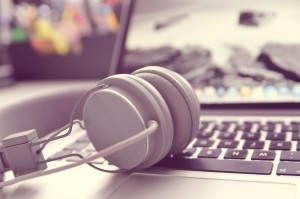 This is a little look behind the scenes of the Dungeon Crawl Classics RPG Actual Play podcast here at The Iron Tavern. Specifically a look at how we record the sessions you have been listening too and some experimentation along the way.
This is a little look behind the scenes of the Dungeon Crawl Classics RPG Actual Play podcast here at The Iron Tavern. Specifically a look at how we record the sessions you have been listening too and some experimentation along the way.
The Original Method
The games are played over Roll20 integrated with a G+ Hangout. Most of us play with headsets, but not all of us. We record in what I suspect many would call an unorthodox way. One of our players who does not use a headset and just an external mic records the whole session from an Apple iTouch using the voice recorder. The iTouch picks up his voice because he is right there in the room and it gets ours from the external speakers.
Once a session is complete, he shares the file with me and I do some rough editing via Audacity. Once the rough edits are done I run it through a leveling tool to help keep the sound of each voice at an equal level. All in all, I think the AP podcast comes out sounding pretty decent.
All of the podcasts in the Sunken City campaign were recorded and edited with this method.
The Experiments
There was interest in coming up with a new recording method. Most of this was there was always the chance the player that recorded couldn’t make a session, which would have left us scurrying for a recording option. Since the game only runs if I am there, it made sense to move the recording method to something I could run.
Take 1
I run on a Mac (I run the sessions from a Mac Mini). A little bit of research on how to record a Google+ Hangout turned up this link:
http://www.seanmeadows.com/2013/06/how-to-record-hangout/
This takes a few tools freely available and gives one a method to record. I whipped up a cheat sheet in Evernote after some testing that ended up like this:
Recording requires three tools:
- Soundflower
- LadioCast
- Audacity
- Launch Soundflowerbed from Applications
- Make sure Headset is checked for Soundflower (2ch)
- Soundflower (64ch) should be set to None.
- Launch LadioCast from the dock
- Set Input 1 to Soundflower (2ch)
- Set Input 2 to Headset (move dB slider to the middle line from the left)
- Set Main Output to Soundflower (64ch)
- Check System Sound Settings (Alt+click on speaker, choose preferences)
- Output should be set to Soundflower (2ch)
- Launch Audacity from the dock
- Confirm to the right of the Mic icon shows Soundflower (64ch)
- Launch the Google Hangout.
- Confirm Audio settings have:
- Input set to Headset
- Output set to Soundflower (2ch)
- Confirm Audio settings have:
This was all prepped for the new campaign start, though we had a backup recording running too.
This method was not without hiccups. First, my sound from the Hangout would drop out sometimes requiring me to go into the Hangout settings and play the test sound, which fixed it. That happened 3 times in a 2 hour session.
Another issue was getting the right input level for my mic. Set too high and it was picking up all sorts of background noise and ended up leaving a weird echo in the recording. Set too low and I wasn’t sure Levelator would be able to fix it.
Turns out in actual use this method wasn’t so great. Back to the drawing board.
Take 2
So I poked around a bit and finally settled on trying the obvious. A Google+ Hangout on Air. After a little reading I learned how to do a Hangout on Air without making it public. Not that difficult.
By using this method I could run the game as a Hangout on Air which will auto-upload the video to my YouTube channel. The permissions were such that the video was not public, but I could access it. In YouTube I have the option to download the file as an mp4 file. Download the file, open it in QuickTime and export the audio only. The end result was a pretty decent quality audio file of our game. Way less tweaking than the option above and helped get the recording role to me, since I have to be there for the game to happen.
We gave it a whirl for the game this week and it seems to have worked great! The video was uploaded to YouTube with no issues. I was able to download the file to my laptop (around 1GB for the session) and then open it in QuickTime. It was easy to export only the audio and I was able to open it in Audacity with no trouble. This is looking like the new way for us to record sessions.
That’s a Wrap
That is the way we recording season 1 of the podcast, the Sunken City campaign. Perhaps my experiments for recording season 2 will help other folks considering recording their games on G+ – either for their own collection or a podcast of their own.

I would have thought everyone recording on their own end, sending them to a single point of contact, drop them all in separate tracks into garageband or audacity, sync the tracks, set levels, mix down, done would result in a better recording. But if the youtube method works…good on ya! I know plenty of actual play shows’ sound quality is terrible.
Oh – I am sure that method would be even better. I’m just not likely to get everyone that plays in the game setup for recording and such. So the YouTube method seems a very good compromise for me.